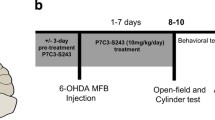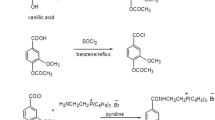Summary
Intranigral infusion of 1-Methyl-4-phenylpyridinium ion (MPP+, 2.1–16.8 nmol) dose-dependently injured nigral neurons as reflected by reduced dopamine levels in the ipsilateral striatum four days after the infusion of this toxic metabolite of 1-methyl-4-phenyl-1,2,3,6-tetrahydropyridine (MPTP). Coadministration of deprenyl (4.2 nmol) with MPP+ into the substantia nigra protected against MPP+-induced moderate (20–50%) but not severe (over 70%) nigral injury as reflected in striatal dopamine reductions. However, supplementary treatment with deprenyl (0.25 mg/kg, s.c., twice daily for 4 days) after intranigral infusion of MPP+ significantly rescued nigral neurons from more severe damage caused by a higher MPP+ does (8.4 nmol) manifested by a lesser striatal dopamine decrease (−31%) compared to the non-deprenyl treated group (−70%). Thus, in addition to the blockade of bioactivation of MPTP, deprenyl can protect and/or rescue nigral neurons from MPP+-induced dopaminergic neurotoxicity. These in vivo data add further evidence to suggest that deprenyl, a putative and clinically unproven neuroprotective agent, may be of value in slowing the progressive nigral degeneration in “early” Parkinson's disease, but may prove to be less so in its terminal stages.
Similar content being viewed by others
References
Adams JD Jr, Odunze IN (1991a) Biochemical mechanisms of 1-methyl-4-phenyl-1,2,3,6-tetrahydropyridine toxicity: could oxidative stress be involved in the brain? Biochem Pharmacol 41: 1099–1105
Adams JD, Odunze IN (1991b) Oxygen free radicals and Parkinson's disease. Free Radic Biol Med 10: 161–169
Ahola T, Haapalinna A, Heinonen E, Hervonen A, Suhonen J (1994) Protection byl-deprenyl of intact peripheral sympathetic neurons exposed to neurotoxin 6-hydroxydopamine. New Trends Clin Neuropharm 8: 287
Ben-Shachar D, Riederer P, Youdim MBH (1991) Iron-melanin interaction and lipid peroxidation: implications for Parkinson's disease. J Neurochem 57: 1609–1614
Bernheimer H, Birkmayer W, Hornykiewicz O (1973) Brain dopamine and the syndromes of Parkinson and Huntington: clinical, morphological and neurochemical correlations. J Neurol Sci 20: 415–455
Birkmayer W, Riederer P, Youdim MBH, Linauer W (1975) The potentiation of the antiakinetic effect after L-dopa treatment by an inhibitor of MAO-B, deprenyl. J Neural Transm 36: 303–326
Birkmayer W, Knoll J, Riederer P, Youdim MBH, Hars V, Marton J (1985) Increased life expectancy resulting from addition ofl-deprenyl to Madopar treatment in Parkinson's disease: a long-term study. J Neural Transm 64: 113–127
Burns RS, Chiueh CC, Markey SP, Ebert MH, Jacobowitz DM, Kopin IJ (1983) A primate model of Parkinsonism: selective destruction of dopaminergic neurons in the pars compacta of the substantia nigra by N-methyl-4-phenyl-1,2,3,6-tetrahydropyridine. Proc Natl Acad Sci USA 80: 4546–4550
Carrillo MC, Kitani K, Kanai S, Sato Y, Miyasaka K, Ivy GO (1994) (−)Deprenyl increases activities of superoxidase and catalase in certain brain regions in old male mice. Life Sci 54: 975–981
Chiba K, Trevor A, Castagnoli N Jr (1984) Metabolism of the neurotoxic tertiary amine, MPTP, by brain monoamine oxidase. Biochem Biophys Res Commun 120: 574–578
Chiueh CC (1988) Dopamine in the extrapyramidal motor function: a study based upon the MPTP-induced primate model of Parkinsonism. Ann NY Acad Sci 515: 226–238
Chiueh CC, Krishna G, Tulsi P, Obata T, Lang K, Huang SJ, Murphy DL (1992a) Intracranial microdialysis of salicylic acid to detect hydroxyl radical generation through dopamine autoxidation in the caudate nucleus: effects of MPP+. Free Radic Biol Med 13: 581–583
Chiueh CC, Huang S-J, Murphy DL (1992b) Enhanced hydroxyl radical generation by 2′-methyl analog of MPTP: suppression by clorgyline and deprenyl. Synapse 11: 346–348
Chiueh CC, Miyake H, Peng MT (1993) Role of dopamine autoxidation, hydroxyl radical generation, and calcium overload in underling mechanisms involved in MPTP-induced parkinsonism. Adv Neurol 60: 251–258
Chiueh CC, Huang SJ, Murphy DL (1994) Suppression of hydroxyl radical formation by MAO inhibitors: a novel possible neuroprotective mechanism in dopaminergic neurotoxicity. J Neural Transm [Suppl] 41: 189–196
Cohen G (1988) Oxygen radicals and Parkinson's disease. In: Halliwell B (ed) Oxygen radicals and tissue injury. FASEB, Bethesda, pp 130–135
Cohen G, Spina MB (1989) Deprenyl suppressed the oxidant stress associated with increased dopamine turnover. Ann Neurol 26: 689–690
Fahn S, Cohen G (1992) The oxidant stress hypothesis in Parkinson's disease: evidence supporting it. Ann Neurol 32: 804–812
Fornstedt B, Brun A, Rosengren E, Carlsson A (1989) The apparent autoxidation rate of catechols in dopamine-rich regions of human brains increases with the degree of depigmentation of substantia nigra. J Neural Transm [P-D Sect] 1: 279–295
Gerlach M, Riederer P, Youdim MBH (1992) The molecular pharmacology ofl-deprenyl. Eur J Pharmacol 226: 97–108
Halliwell B, Gutteridge JMC (1989) Free radicals in biology and medicine, 2nd edn. Oxford University Press, New York, pp 188–276
Hornykiewicz O (1982) Brain transmitter changes in Parkinson's disease. In: Marsden CD, Fahn S (eds) Movement disorders. Butterworth & Co, London, pp 41–58
Jenner P (1991) Oxidative stress as a cause of Parkinson's disease. Acta Neurol Scand [Suppl] 84: 136: 6–15
Knoll J, Toth V, Kummer M, Sugar J (1992) (−)Deprenyl- and (−)parafluorodeprenyl-treatment prevents age-related pigment changes in the substantia nigra. A TV-image analysis of neuromelanin. Mech Ageing Dev 63: 157–163
Langsten JW, Ballard P, Tetrud JW, Irwin I (1983) Chronic parkinsonism in humans due to a product of meperidine-analog synthesis. Science 219: 979–980
Markey SP, Johannessen JN, Chiueh CC, Burns RS, Herkenham MA (1984) Intraneuronal generation of a pyridinium metabolite may cause drug-induced parkinsonism. Nature 311: 464–476
Mytilineou C, Cohen G (1985) Deprenyl protects dopamine neurons from the neurotoxic effects of 1-methyl-4-phenylpyridinium ion. J Neurochem 45: 1951–1953
Olanow CW, Calne D (1992) Does selegiline monotherapy in Parkinson's disease act by symptomatic or protective mechanism? Neurology 42 [Suppl 4]: 13–26
Olanow CW (1992) An introduction to the free radical hypothesis in Parkinson's disease. Ann Neurol 32: 2–9
Parkinson Study Group (1989) Effect of deprenyl on the progression of disability in early Parkinson's disease. N Engl J Med 321: 1364–1371
Parkinson Study Group (1993) Effects of tocopherol and deprenyl on the progression of disability in early Parkinson's disease. N Engl J Med 328: 176–183
Paxinos G, Watson C (1986) The rat brain in stereotaxic coordinates, 2nd ed. Academic Press, San Diego
Roy E, Bedard PJ (1993) Deprenyl increases survival of rat foetal nigral neurons in culture. NeuroReport 4: 1183–1186
Schmidt DE, Lynn JC, Ebert MH, Whetsell WO Jr (1993) Attenuation of 1-methyl-4-phenylpyridinium neurotoxicity by deprenyl in organotypic cultures of canine substantia nigra. Soc Neurosci Abstr 19: 1680 (#686.15)
Schulzer M, Mak E, Calne DB (1993) The antiparkinson efficacy of deprenyl derives from transient improvement that is likely to be symptomatic. Ann Neurol 32: 795–798
Spina MB, Cohen G (1989) Dopamine turnover and glutathione oxidation: implications for Parkinson disease. Proc Natl Acad Sci USA 86: 1398–1400
Suhonen J, Ahola T, Haapalinna A, Heinonen E, Hervonen A (1994) Short-term and long-term l-deprenyl treatment may improve the survival of grafted young and aged sympathetic ganglion cells. New Trends Clin Neuropharm 8: 328–329
Sun CJ, Johannessen JN, Gessner W, Namura I, Singhaniyom W, Brossi A, Chiueh CC (1988) Neurotoxic damage to the nigrostriatal system in rats following intranigral administration of MPDP+ and MPP+. J Neural Transm 74: 75–86
Tatton WG, Greenwood CE (1991) Rescue of dying neurons: a new action for deprenyl in MPTP parkinsonism. J Neurosci Res 30: 666–672
Tatton WG (1993) Selegiline can mediate neuronal rescue rather than neuronal protection. Mov Disord 8 [Suppl 1]: S20–30
Tetrud JW, Langsten JW (1989) The effect of deprenyl (selegiline) on the natural history of Parkinson's disease. Science 245: 519–522
Vizuete ML, Steffen V, Ayala A, Cano J, Machado A (1993) Protective effect of deprenyl against 1-methyl-4-phenylpyridinium neurotoxicity in rat striatum. Neurosci Lett 152: 113–116
Wu R-M, Chiueh CC, Murphy DL (1993a) Antioxidant effect of deprenyl on hydroxyl radical generation elicited by MPP+ in vivo. FASEB J Abst 7: A38 (#215)
Wu R-M, Chiueh CC, Pert A, Murphy DL (1993b) Apparent antioxidant effect ofl-deprenyl on hydroxyl radical formation and nigral injury elicited by MPP+ in vivo. Eur J Pharmacol 243: 241–247
Wu R-M, Murphy DL, Chiueh CC (1994) Protection of nigral neurons against MPP+-induced oxidative injury by deprenyl (selegiline), U-78517F, and DMSO. New Trends Clin Neuropharm 8: 187–188
Author information
Authors and Affiliations
Rights and permissions
About this article
Cite this article
Wu, R.M., Murphy, D.L. & Chiueh, C.C. Neuronal protective and rescue effects of deprenyl against MPP+ dopaminergic toxicity. J. Neural Transmission 100, 53–61 (1995). https://doi.org/10.1007/BF01276865
Received:
Accepted:
Issue Date:
DOI: https://doi.org/10.1007/BF01276865




